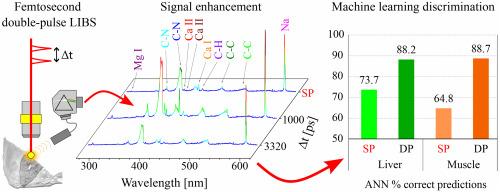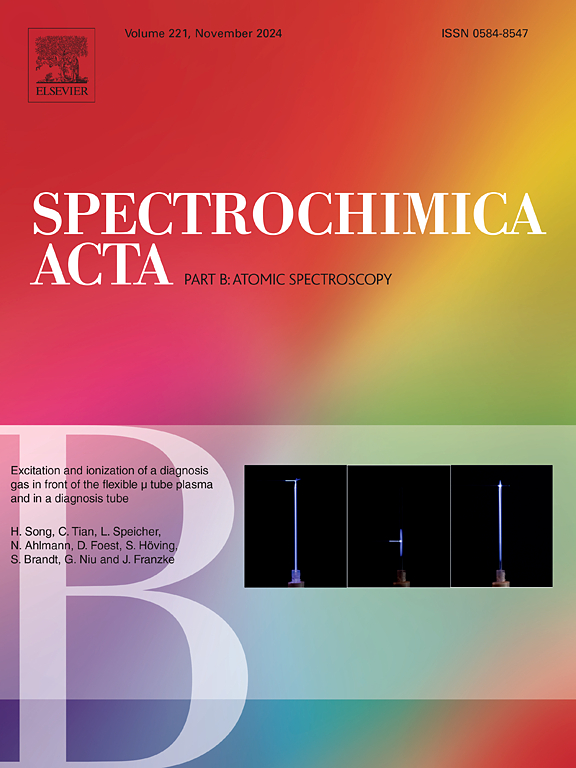Signal enhancement with double-pulse LIBS on biological samples and better discrimination of tissues through machine learning algorithms
IF 3.2
2区 化学
Q1 SPECTROSCOPY
引用次数: 0
Abstract
Laser-induced breakdown spectroscopy (LIBS) is a widely used technique in the field of spectroscopy, enabling the determination of the chemical composition of a variety of samples using typically single laser pulses. This paper presents the successful integration of femtosecond LIBS using double pulses that combined with machine learning algorithms enhanced the discrimination between two animal tissue types (liver and muscle) through the detection of atomic and molecular emissions. The double-pulse configuration was optimized on liver tissue, and the results demonstrated that at 1100 ps pulse delay, the signal was the highest overall for all identified lines, with a fivefold increase compared to single-pulse configuration at comparable energies. By employing femtosecond double-pulse LIBS, it is possible to achieve enhanced signal quality with a better signal-to-noise ratio. Both algorithms used here (Artificial Neural Network and Random Forest) consequently demonstrate superior performance in tissue type prediction when double pulses are employed, as compared to single pulses. The combination of femtosecond double-pulse LIBS with machine learning algorithms has the potential to be an effective technique for thin biological samples (for example biopsy sections), with minimal ablation.

在生物样品上使用双脉冲 LIBS 增强信号,并通过机器学习算法更好地分辨组织
激光诱导击穿光谱(LIBS)是光谱学领域广泛使用的一种技术,通常使用单激光脉冲就能测定各种样品的化学成分。本文介绍了飞秒激光击穿光谱与双脉冲的成功集成,它与机器学习算法相结合,通过检测原子和分子发射,增强了对两种动物组织类型(肝脏和肌肉)的分辨能力。在肝脏组织上对双脉冲配置进行了优化,结果表明,在 1100 ps 脉冲延迟时,所有识别线的信号总体最高,在可比能量下比单脉冲配置增加了五倍。通过采用飞秒双脉冲 LIBS,可以获得信噪比更高的信号质量。因此,与单脉冲相比,在采用双脉冲时,这里使用的两种算法(人工神经网络和随机森林)在组织类型预测方面都表现出更优越的性能。飞秒双脉冲 LIBS 与机器学习算法的结合有可能成为一种有效的技术,可用于薄生物样本(例如活检切片),且烧蚀程度极低。
本文章由计算机程序翻译,如有差异,请以英文原文为准。
求助全文
约1分钟内获得全文
求助全文
来源期刊
CiteScore
6.10
自引率
12.10%
发文量
173
审稿时长
81 days
期刊介绍:
Spectrochimica Acta Part B: Atomic Spectroscopy, is intended for the rapid publication of both original work and reviews in the following fields:
Atomic Emission (AES), Atomic Absorption (AAS) and Atomic Fluorescence (AFS) spectroscopy;
Mass Spectrometry (MS) for inorganic analysis covering Spark Source (SS-MS), Inductively Coupled Plasma (ICP-MS), Glow Discharge (GD-MS), and Secondary Ion Mass Spectrometry (SIMS).
Laser induced atomic spectroscopy for inorganic analysis, including non-linear optical laser spectroscopy, covering Laser Enhanced Ionization (LEI), Laser Induced Fluorescence (LIF), Resonance Ionization Spectroscopy (RIS) and Resonance Ionization Mass Spectrometry (RIMS); Laser Induced Breakdown Spectroscopy (LIBS); Cavity Ringdown Spectroscopy (CRDS), Laser Ablation Inductively Coupled Plasma Atomic Emission Spectroscopy (LA-ICP-AES) and Laser Ablation Inductively Coupled Plasma Mass Spectrometry (LA-ICP-MS).
X-ray spectrometry, X-ray Optics and Microanalysis, including X-ray fluorescence spectrometry (XRF) and related techniques, in particular Total-reflection X-ray Fluorescence Spectrometry (TXRF), and Synchrotron Radiation-excited Total reflection XRF (SR-TXRF).
Manuscripts dealing with (i) fundamentals, (ii) methodology development, (iii)instrumentation, and (iv) applications, can be submitted for publication.

 求助内容:
求助内容: 应助结果提醒方式:
应助结果提醒方式:


